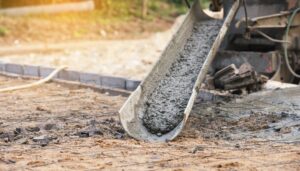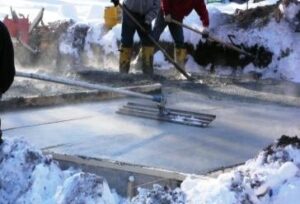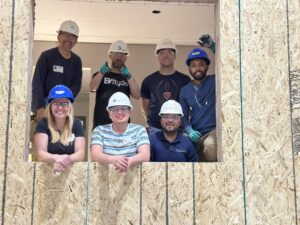As a building inspector, I encounter many different types of inspections. However, the type of inspections I perform on a daily basis primarily deal with some facet of foundation inspection. With a change of seasons and cold weather moving in, it is important to note the process of pouring concrete needs to change with the drop in temperature.
Temperature Can and Will Effect Concrete When Pouring
With the technology utilized in today’s construction workplace, concrete can be poured at lower temperatures with no harmful effects. In fact, concrete can be poured at a low temperature of 25 degrees with minimal risk of freezing. To reduce harmful effects, there are many factors that should be considered when pouring concrete in cold weather. One of the main elements to consider is the lowest temperature point within the next 24 hours, as well as the duration of that low temperature. In milder temperatures (70 degrees), concrete will reach a critical 500 PSI mark within 24 hours. At 40 degrees it can take up to three days to reach that critical 500 PSI mark. The 500 PSI mark is critical because freezing is unlikely at that point. If it does freeze after reaching 500 PSI, it typically will not impact the strength of the concrete. However, if the concrete freezes before the 500 PSI mark, you risk the concrete losing 50% of its original strength.
Here are a few facts to know about cold weather concrete:
- Concrete will freeze if the temperature falls below 25 degrees.
- Freshly mixed concrete must be protected against freezing until it reaches 500 psi.
- Concrete gains very little early strength at low temperatures (40 degrees and below).
- Significant overall reductions in strength gain, up to 50%, can occur if concrete is frozen before it reaches 500 psi.
- At 40 degrees concrete could take up to 3 days to reach 500 psi.
- At normal temperatures (70 degrees) concrete usually reaches 500 psi in the first 24 hours.
Tips When Pouring Concrete at Lower Temperatures
Contractors use many different approaches to pouring concrete in the cold – everything from doing nothing to protect the project from the elements to tenting and heating an entire area. However, concrete can be successfully poured in cold weather by using a few simple preventive methods:
- Do not pour concrete on frozen surfaces: Pouring concrete on a frozen surface can obviously cause the concrete itself to freeze. But other issues can arise as well, such as uneven settlement due to expansion and contraction. If this happens after the concrete has set up, it may result in cracking.
- Protect your pour from freeze: When pouring concrete in the cold (below 32 degrees), protect it from freezing by using thermal blankets. Keep the forms in place until the temperature reaches at least 32 degrees for a 24-hour period.
- Use warm materials: Using warm materials will naturally protect the concrete from freezing while the completing the pour. All the materials should be warm, including the forms, tools and (most importantly) the concrete. Most ready-mix concrete companies can batch the mix with warm water, allowing the mix to remain around 70 degrees when poured.
These suggestions are simple, but they can make the difference between a successful pour and a failed pour. In the up-and-coming cold weather months if any field services are needed we can provide guidance, direction, and most professional inspections. Simply reach out to EVstudio Field Services team and we can provide all the services needed to complete your project.
For more information on concrete and field services inspections please take a look at the following article; Honeycombing in Concrete Walls -Inspections EVstudio.










